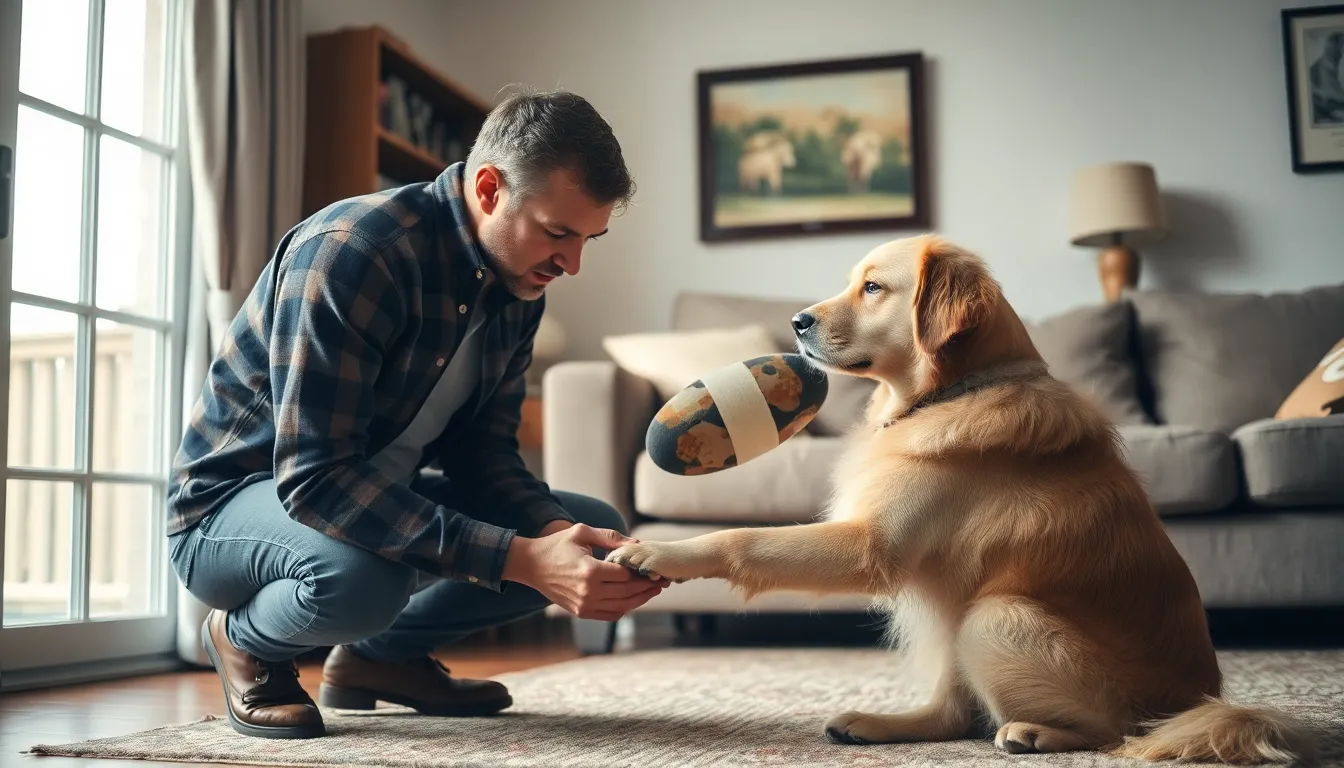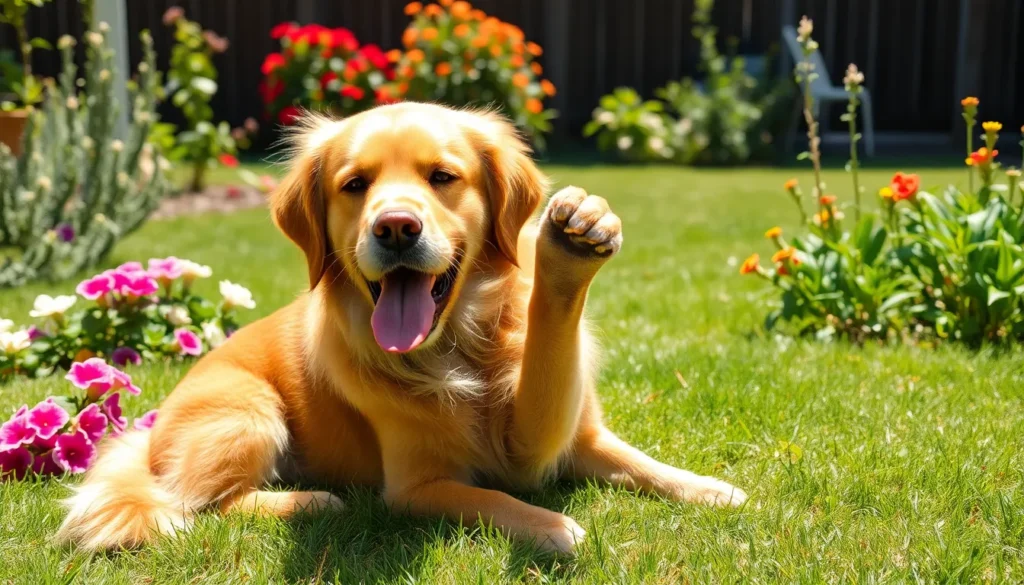Table of Contents
ToggleEver catch your dog in a licking frenzy, paws flailing like a doggy spa day gone rogue? While it might seem like a quirky habit, there’s more to this behavior than meets the eye. Dogs lick their paws for various reasons—some harmless and others that might raise an eyebrow or two.
Understanding Canine Behavior
Dogs display various behaviors, and licking paws often signifies their attempts to communicate a need or express discomfort. Frequent licking can stem from allergies, both environmental and food-related. Allergic reactions frequently lead to itchy skin, prompting dogs to lick the affected areas for relief.
In addition to allergies, boredom contributes to this behavior. A lack of physical and mental stimulation may result in dogs developing habits like excessive licking as an outlet for energy. Thus, it’s important to provide regular exercise and engaging activities.
Some dogs lick their paws due to pain or injury. A cut, thorn, or insect sting can cause localized discomfort. Inspecting the paws for visible signs of injury is essential. If painful conditions persist, consulting a veterinarian is advisable.
Anxiety and stress also provoke paw licking. Situations like changes in the home environment or exposure to loud noises can lead to nervousness. Offering a safe space and comfort items can alleviate anxiety-related behaviors.
Another cause for licking can be habit formation. Dogs often develop repetitive actions, especially when stressed or bored. This compulsive behavior may require intervention from a professional animal behaviorist for effective management.
Recognizing the context behind such behaviors can significantly aid in addressing them effectively. Observing patterns and triggers plays a crucial role. Understanding canine behavior offers insights into their needs and well-being.
Common Reasons For Paw Licking

Licking paws can stem from multiple issues, and understanding these can help address the behavior effectively.
Allergies
Allergies are one of the most common reasons for paw licking in dogs. Both environmental allergens and food-related ingredients can trigger reactions. Affected dogs often experience itchy or irritated skin, prompting them to lick for relief. Seasonal allergens like pollen or dust mites frequently cause these issues during certain times of the year. If food allergies are suspected, a specific diet trial can identify problematic ingredients. Monitoring the dog’s diet and environment allows for better management of allergic reactions.
Skin Conditions
Skin conditions may also lead to paw licking. Dermatitis, infections, or conditions like eczema can irritate a dog’s skin, driving them to seek comfort through licking. The presence of redness or swelling often indicates these conditions. Regular grooming helps prevent matting and irritation, reducing the likelihood of skin issues. Keeping the dog’s skin clean and moisturized can also support overall health. A veterinarian can recommend appropriate treatments, ensuring effective management of any identified skin problems.
Injury or Pain
Injury or pain can result in localized licking as dogs attempt to soothe sore or injured areas. Cuts, scrapes, or insect bites may cause discomfort, leading to increased licking. Evaluating the dog’s paws for visible signs of injury is essential. If an injury is detected, proper care or veterinary attention may be necessary. Pain from underlying issues, such as arthritis, may also prompt licking. Monitoring changes in behavior helps address potential pain-related issues efficiently.
Behavioral Factors
Understanding behavioral factors helps explain why a dog might lick her paws. Dogs also lick their paws in response to various emotions, particularly boredom and anxiety.
Boredom or Anxiety
Boredom often drives dogs to engage in repetitive behaviors, including paw licking. When dogs lack adequate physical and mental stimulation, they seek ways to expel pent-up energy. Dogs often turn to licking as a distraction from their uneventful surroundings. Anxiety can also trigger this behavior, especially during stressful situations, such as changes at home or loud noises in the environment. For instance, many dogs lick their paws during thunderstorms or when new people enter their space. Providing toys and regular exercise may alleviate both boredom and anxiety.
Habitual Licking
Habitual licking frequently develops when a dog licks her paws out of habit, often without an underlying physical cause. This behavior can become reflexive over time, leading to excessive licking even in the absence of stress or discomfort. It’s important to recognize that as the licking continues, it may cause further skin irritation. Observing the frequency of this behavior is essential for determining when to consult a veterinarian or a professional behaviorist. In many cases, introducing training techniques or distractions helps break the cycle of habitual licking.
When To Consult A Veterinarian
Recognizing when to seek veterinary care for a dog licking her paws is crucial for her health. Persistent licking, particularly when accompanied by other symptoms, warrants professional evaluation.
Signs That Require Immediate Attention
Watching for specific signs can indicate a need for urgent care. Swelling or redness in the paws suggests inflammation or infection. A noticeable change in behavior, such as increased lethargy or aggression, may signal pain or distress. Excessive licking leading to raw or bleeding areas indicates a serious problem. If your dog exhibits signs of allergic reactions, like sneezing or gastrointestinal upset, consult a veterinarian promptly. These symptoms require timely intervention to prevent further complications.
Preventive Measures
Implementing preventive measures can significantly reduce paw licking behavior. Regular grooming helps maintain healthy skin and identify potential irritants early. Providing ample physical and mental stimulation prevents boredom that leads to licking. Monitoring the dog’s environment helps eliminate allergens like pollen or dust. Nutritional adjustments, particularly addressing food allergies, can alleviate discomfort. Training techniques aimed at redirecting licking can also be effective. Combining these strategies supports overall paw health and diminishes the urge to lick.
Understanding why a dog licks her paws is essential for addressing potential health issues and ensuring her well-being. While occasional licking can be normal, persistent behavior may indicate allergies, injuries, or anxiety. Owners should pay close attention to the frequency and context of this behavior.
Regular grooming and monitoring for signs of irritation can help prevent excessive licking. Providing mental and physical stimulation can reduce boredom-related licking. If the behavior escalates or is accompanied by concerning symptoms, seeking veterinary advice is crucial. By staying proactive and informed, dog owners can support their furry friends and promote healthier habits.





